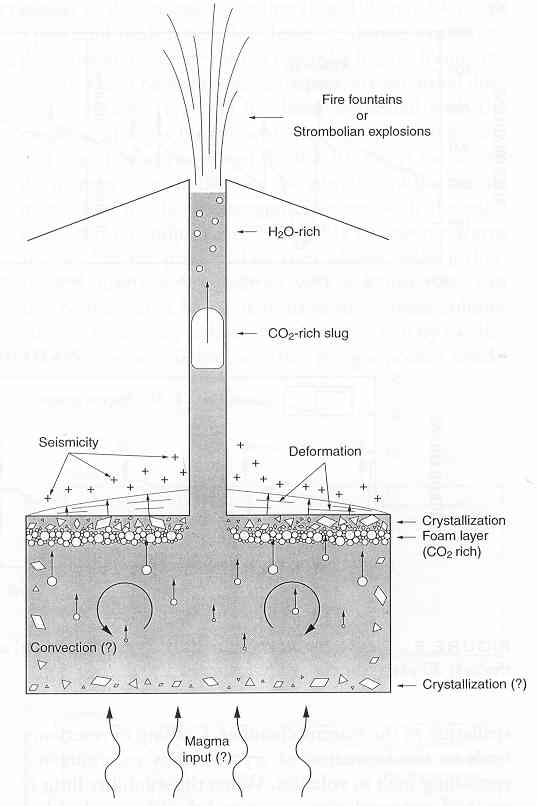
provided by USGS
Figure 1
There are three major types of explosive eruptions:
It is important to note that eruption styles can change. Changes in eruption styles are a function of changes in magma composition and crystallinity, the amount and nature of exsolved volatiles, vent and conduit geometry and access to external water.
Plinian
In
a plinian eruption a mixture of gas and particles are emitted from the vent
at velocities from 100 – 400m/s, these type of eruptions can last from
minutes to hours. Plinian eruptions are usually initiated by the fracturing
of rocks overlying the magma, which causes the magma to rise. As the pressure
decreases as the magma rises, over saturation of the magma occurs causing over
saturation of the magma and results in the release of dissolved volatile components.
The acceleration and volume increase of these exsolved fluids result in fragmentation.
It is at this point in the magma’s ascent that there is a very high value
of mixture acceleration which affects the magma rise velocity. In figure 1 the
different zones of an eruption column are seen along with the variation in density,
pressure and velocity of the erupting mixture (Cioni et al, 2000).

provided by USGS
Figure 1
Strombolian
Strombolian
eruptions are one of the least violent types of eruptions. Due to the low viscosity
of the magma, typically basalt or basaltic andesite, the gases in the magma
are able to escape resulting in reduced intensity and magnitude. Gases are usually
released in rhythmic bursts which disrupt the top of the magma column so only
that portion of the column is erupted. In figure 2 (Vergniolle and Mangan, 2000)
the eruption column of a strombolian volcano is seen. The eruptive process occurs
in 2 phases and is based upon the gas-volume ratio of the magma.

 Figure
2
Figure
2
photo provided by
www.iavcei.org/Seismology.htm
Vulcanian
Vulcanian eruptions are defined as small to moderate eruptions that eject material to heights up to <20km and are characterized by discrete violent eruptions. These eruptions occur by ballistic ejection of blocks and bombs, by atmospheric shock waves and the emission of tephra and juvenile components. Since the distance of the material ejected is so large it is obvious that the pressure required to accelerate them must also be large. Velocities have been calculated to be up to 200m/s, but observations at volcanoes, like Arenal (below) have been up to 400m/s. Today’s estimates of pressures needed to produce these velocities are expected to be~10 M Pa

photo provided by:
www.dimijianimages.com/CostaRica-page2/
Arenal-erupting.htm